The Intel Corporation, which is one of the world’s leading semiconductor firms, has been involved in significant restructuring so as to face intense competition and market challenges. The company is planning a massive layoff involving over 15,000 employees. This move forms part of global plans to save $10 billion by 2025 and make its operations efficient enough to be able to compete effectively in a fast-paced technology market.
Workforce Reduction and Cost-Saving Measures
Intel intends to lay off about 15 percent or 15,000 workers from its workforce as a measure aimed at costs cutting and enhancing fiscal stability. The company intends to cut this cost by around billions each year from now till 2026 through decreasing such amounts spent on marketing and research and development (R&D). In addition, Intel will reduce capital expenditure for more than 20% in this year alone while reorganizing its activities to eliminate unimportant work.
Financial Performance and Market Position
Intel had an uninspiring financial performance after declaring a loss of $1.6 billion during Q2-2024 compared with the previous quarter that had recorded $437 million loss. Despite stable sales in other businesses like PC & servers most of these losses have been attributed towards foundry division. This financial strain combined with the fact that Intel earnings have fallen significantly as compared to previous years, with an abrupt decline of up to 33% within only one day.
Competitive Pressures and Strategic Shifts
On top of competitive pressures from companies such as Nvidia & AMD, there are other factors that affect Intel’s operations negatively. In particular, Nvidia was ranked among some world’s most profitable corporations according to their performances during 2024 implying high level competition posed on Intel. To counterbalance this trend, Intel started projects like Intel Arc in order for it to compete against Nvidia within CPU market then the next flagship AI laptop chip Lunar Lake might not be enough to restore the fortunes of Intel alone.
Historical Context and Future Outlook
Intel’s historical blunders include not investing sufficiently during the mobile technology wave, which has propelled other tech companies to great heights. Despite earning $24 billion less, its workforce is now 10% bigger than it was back in 2020. This situation points to the need for bold steps by Intel if it is to grow while maintaining a leaner operational structure.
Pat Gelsinger, CEO of Intel, underscored how determined the company is to adapt to market realities and drive growth. Today, the focus of this company is on retaining its core investments in order to create resilient and sustainable semiconductor supply chains both within US and globally. The majority of these layoffs will be completed by end of 2024.
Intel’s decision to lay off over 15,000 employees forms part of the overall strategy regarding cutting costs in order to survive in difficult market conditions. These drastic measures have been necessitated by intense competition from rivals such as Nvidia coupled with a poor financial position experienced by Intel. For now, during this period of restructuring its focus will be on maintaining core investments and building a sustainable future for itself within the semiconductor industry.


